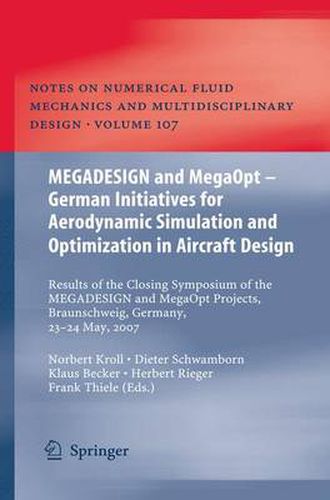Readings Newsletter
Become a Readings Member to make your shopping experience even easier.
Sign in or sign up for free!
You’re not far away from qualifying for FREE standard shipping within Australia
You’ve qualified for FREE standard shipping within Australia
The cart is loading…






This title is printed to order. This book may have been self-published. If so, we cannot guarantee the quality of the content. In the main most books will have gone through the editing process however some may not. We therefore suggest that you be aware of this before ordering this book. If in doubt check either the author or publisher’s details as we are unable to accept any returns unless they are faulty. Please contact us if you have any questions.
Over the last decade, Computational Fluid Dynamics (CFD) has become a - ture technology for the development of new products in aeronautical industry. Aerodynamic design engineers have progressively taken advantage of the pos- bilities o?ered by the numericalsolutionof the Reynolds averagedNavier-Stokes (RANS) equations. Signi?cant improvements in physical modeling and solution algorithms as well as the enormous increase of computer power enable hi- ?delity numerical simulations in all stages of aircraft development. In Germany, the national CFD project MEGAFLOW furthered the dev- opment and availability of RANS solvers for the prediction of complex ?ow problemssigni?cantly. MEGAFLOWwasinitiated by the?rstaviationresearch programoftheFederalGovernmentin1995undertheleadershipoftheDLR(see Kroll, N. , Fassbender, J. K. (Eds). : MEGAFLOW - Numerical Flow Simulation for Aircraft Design; Notes on Numerical Fluid Mechanics and Multidisciplinary Design, Volume 89, Springer, 2005). A network from aircraft industry, DLR and several universities was created with the goal to focus and direct development activities for numerical ?ow simulation towards a common aerodynamic si- lation system providing both a block-structured (FLOWer-Code) and a hybrid (TAU-Code) parallel ? ow prediction capability. Today, both codes have reached a high level of maturity and reliability. They are routinely used at DLR and German aeronautic industry for a wide range of aerodynamic applications. For many universities the MEGAFLOW software represents a platform for the - provementofphysicalmodelsandfortheinvestigationofcomplex?owproblems. The network was established as an e?cient group of very closely co-operating partners with supplementing expertises and experience.
$9.00 standard shipping within Australia
FREE standard shipping within Australia for orders over $100.00
Express & International shipping calculated at checkout
This title is printed to order. This book may have been self-published. If so, we cannot guarantee the quality of the content. In the main most books will have gone through the editing process however some may not. We therefore suggest that you be aware of this before ordering this book. If in doubt check either the author or publisher’s details as we are unable to accept any returns unless they are faulty. Please contact us if you have any questions.
Over the last decade, Computational Fluid Dynamics (CFD) has become a - ture technology for the development of new products in aeronautical industry. Aerodynamic design engineers have progressively taken advantage of the pos- bilities o?ered by the numericalsolutionof the Reynolds averagedNavier-Stokes (RANS) equations. Signi?cant improvements in physical modeling and solution algorithms as well as the enormous increase of computer power enable hi- ?delity numerical simulations in all stages of aircraft development. In Germany, the national CFD project MEGAFLOW furthered the dev- opment and availability of RANS solvers for the prediction of complex ?ow problemssigni?cantly. MEGAFLOWwasinitiated by the?rstaviationresearch programoftheFederalGovernmentin1995undertheleadershipoftheDLR(see Kroll, N. , Fassbender, J. K. (Eds). : MEGAFLOW - Numerical Flow Simulation for Aircraft Design; Notes on Numerical Fluid Mechanics and Multidisciplinary Design, Volume 89, Springer, 2005). A network from aircraft industry, DLR and several universities was created with the goal to focus and direct development activities for numerical ?ow simulation towards a common aerodynamic si- lation system providing both a block-structured (FLOWer-Code) and a hybrid (TAU-Code) parallel ? ow prediction capability. Today, both codes have reached a high level of maturity and reliability. They are routinely used at DLR and German aeronautic industry for a wide range of aerodynamic applications. For many universities the MEGAFLOW software represents a platform for the - provementofphysicalmodelsandfortheinvestigationofcomplex?owproblems. The network was established as an e?cient group of very closely co-operating partners with supplementing expertises and experience.